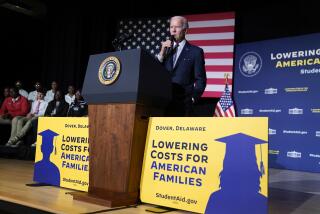Congress OKs Rescue Plan for S & L Fund
- Share via
WASHINGTON — Writing the final chapter in the savings and loan bailout, Congress voted Monday to approve a rescue plan for the federal S&L; insurance fund, requiring thrifts and banks to share the financial burden.
The thrift industry will make a special one-time payment of $4.7 billion in addition to its continuing obligations to the fund. Banks will join for the first time in making interest payments on S&L; cleanup bonds, which will cost them about $11.9 billion over the next 20 years.
By providing billions of dollars in new money, the agreement is designed to avert a potential taxpayer bailout for the weakened S&L; insurance fund, which guarantees deposits up to $100,000.
House Banking Committee Chairman Jim Leach (R-Iowa) called the legislation historic. Legislators can return to their districts, Leach said, “and report that they have addressed the last remaining aspect of the savings and loan debacle without any further taxpayer accountability.”
Taxpayers already “have paid more than their fair share,” Leach said, noting that Congress had spent $130 billion to close failed S&Ls; and pay off depositors. An estimated $200 billion more will be spent for the interest charges on 30-year bonds used to finance the cleanup.
The fund rescue legislation also takes the financial industry a major step down the road toward the disappearance of a separate thrift industry. The survivors will most likely be broad-based institutions operating like financial department stores, providing checking and savings accounts and offering consumer loans, home mortgages and business credit.
The healthy survivors in the S&L; industry have been paying for the cost of disposing of 747 thrifts that collapsed in the 1980s. For every $100 in deposits that they held, the thrifts were paying 23 cents to rebuild the shrunken insurance fund. Banks, whose fund was in stronger shape, were paying nothing for their deposit insurance other than a $2,000 annual fee.
The S&Ls;, especially some of the industry giants in California, have been seeking bank charters so they could shift deposits and avoid the added insurance cost of the S&L; fund. Federal regulators had nightmares of a steady drain of deposits from the S&L; fund and an ultimate taxpayer rescue if a big thrift were to fail in the future.
The legislation passed Monday, which is contained in the massive continuing resolution to operate much of the federal government, will bring the S&L; fund back to fiscal health, eventually reaching the statutory goal of $1.25 for every $100 in deposits.
Under the terms of the bill, the insurance premium paid by S&Ls; will drop from 23 cents per $100 of deposits now to 6.44 cents for the next three years, for a total of $458 million a year.
The banks will pay 1.29 cents per $100 in deposits, contributing $322 million a year for the next three years to pay off the special cleanup bonds.
From 2000 through 2017, the S&Ls; and banks will each contribute 2.43 cents per $100 in deposits. This will cost the thrifts $172 million a year and the banks, which have a much larger deposit base, $608 million.
The banks thus will pay 41% of the cost through the end of the century and 78% for the following 17 years.
In return for their contributions, Congress promised to consider legislation next year to merge the bank and thrift charters into a single license. This would give the banks wide latitude to move into new businesses. Combining the charters would eventually be accompanied by a merger of the insurance funds.
“The task now must be to move forward toward charter modernization in a spirit of purpose and cooperation,” said Paul A. Schosberg, president of America’s Community Bankers, the trade association for the S&L; industry.
Congressional approval “clears a major hurdle that stood in the path of banking’s progress toward the 21st century, and it augurs well for our ability to strengthen banking’s long-term competitive vitality,” he said.
Bankers agreed. “In an unprecedented fashion, the thrift and banking industries together agreed to pay billions of dollars to assure we continue to have a strong financial system,” said Jim Culberson, president of the American Bankers Assn. The next step, Culberson said, should be swift congressional action to combine the separate bank and thrift charters into “a new, expanded charter.”
The bankers made other gains in the legislation, including some regulatory relief.
Banks foreclosing on properties containing hazardous materials will no longer be responsible for costs of the cleanup. Applications will be simplified for bank holding companies seeking to make acquisitions and engage in non-banking activities. And banks will no longer be required to get regulatory approval to open new automated teller machines.
More to Read
Inside the business of entertainment
The Wide Shot brings you news, analysis and insights on everything from streaming wars to production — and what it all means for the future.
You may occasionally receive promotional content from the Los Angeles Times.









